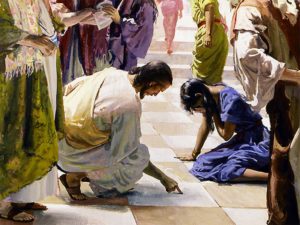Jn 8:1-11
Jesus went to the Mount of Olives.
But early in the morning he arrived again in the temple area,
and all the people started coming to him,
and he sat down and taught them.
Then the scribes and the Pharisees brought a woman
who had been caught in adultery
and made her stand in the middle.
They said to him,
“Teacher, this woman was caught
in the very act of committing adultery.
Now in the law, Moses commanded us to stone such women.
So what do you say?”
They said this to test him,
so that they could have some charge to bring against him.
Jesus bent down and began to write on the ground with his finger.
But when they continued asking him,
he straightened up and said to them,
“Let the one among you who is without sin
be the first to throw a stone at her.”
Again he bent down and wrote on the ground.
And in response, they went away one by one,
beginning with the elders.
So he was left alone with the woman before him.
Then Jesus straightened up and said to her,
“Woman, where are they?
Has no one condemned you?”
She replied, “No one, sir.”
Then Jesus said, “Neither do I condemn you.
Go, and from now on do not sin any more.”
Bishop Barron:
Friends, today’s Gospel presents the story of the woman caught in adultery, which is one of the clearest demonstrations of what René Girard called the scapegoat mechanism.
The scribes and Pharisees bring to Jesus a woman they had caught in adultery. Where must they have been standing and how long must they have been waiting in order to catch her? Their eagerness to find a victim is testimony to the insatiable human need for scapegoats.
The novelty of the Gospel is revealed in Jesus’ refusal to contribute to the energy of the gathering storm: “Let the one among you who is without sin be the first to throw a stone at her.” Jesus directs the energy of scapegoating violence back toward the accusers. He unveils the dangerous secret that the unstable order of the society has been predicated upon scapegoating. The Church Fathers emphasized this point with a neat interpretive move: they imagined that Jesus was writing in the sand none other than the sins of those who were threatening the woman.
Then we see, at least in seminal form, the new order: “Go, and from now on do not sin anymore.” The connection between Jesus and the woman is not the consequence of condemnation but rather the fruit of forgiveness offered and accepted.


Recent Comments